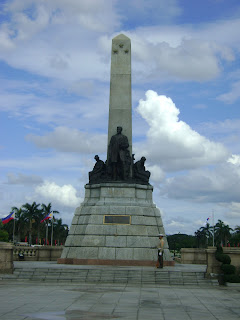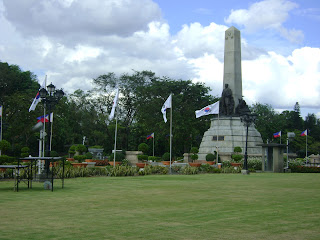For people living a great distance from the country's capital, probably the only view that comes to mind at the mention of the Luneta (Rizal Park) is the monument. This is probably because the monument is the single most photographed portion of the entire vicinity. Here's a virtual tour of Rizal Park, the way the Manileños enjoy it. Click on the images for an enlarged view.
Upon entering the park, a welcome message reads: Mabuhay! Welcome to Rizal Park, the Philippines' premier National Park. Named after our great national hero Dr. Jose P. Rizal, it is a showcase of our country's heritage and culture. Rizal park is also the Kilometer Zero to the best of the Philippine Islands and destinations. Rizal park is our park - your park. Help us in maintaining the cleanliness and beauty of its surroundings and in promoting security, peace and order for a truly enjoyable stay. Maraming salamat po!
For what it's worth, the entire area IS clean, sweepers see to it that the pavement is free of litter, which can be conveniently thrown in trash bins located all over the place every five meters or so. Security is also tight, and guards constantly do a visual sweep of the place, patrolling the grounds in their bicycles.
A security guard, on the aforementioned bicycle.
This is the Vicinity Map of Rizal Park. From this view alone, it is apparent that there's more to this place than just the monument.
This is a wide view of the Luneta. If inspected very closely, this photograph shows the Rizal monument a long distance away, situated to the right of the long-range view of the Philippine flag.
These intricate landscaping designs and cultural works of art can be found all over the park.
Along the length of the Luneta are busts of Filipino heroes, men and women who have made a mark in the country's history. This photograph shows only one of two parallel rows of sculptures. For an individual view of the busts, click here.
At the center of the park is located the dancing fountains. These splendid mechanisms show a colorful display of water and lights and music every night. To see what the show looks like in the evening, click here.
Yes, that's a train. Similar to the ones seen in big malls all over the country that take people on a tour around the area, this train takes visitors on a guided trip around the park -- for a modest fee, of course.
Unlike the traditional kalesa, this one is made from metal frames and rubber wheels and has the American flag painted all over the back seat. There can be much speculation about the rationale behind the designing of this transport vehicle in relation to it being in the National Park, but then again its origin could simply be traced to the eager desire of certain high-ranking people to attract tourists -- give them something familiar in a foreign land to ride on, with a subtle blend of the local culture.
This one is a more native version of the Philippine kalesa, although it still does have a touch of modernity to it. Along the sides are pictures relating to the national hero, Rizal, and places all over the country where structures and monuments built in his honor can be found.
Along the path leading to the Rizal monument are engraved quotations by the national hero. This one reads, "Ibig koy lagi nang makarinig ng pintas sa akin, pagka't nakukuhang pabutihin nito ang mga may hangad magpakabuti," which, in English, translates "I delight in hearing other people criticize me, because reprobation emboldens anyone who wishes to change, to change for the better."
THE RIZAL MONUMENT
Here are shots of the world-famous Rizal monument, which is not only a reminder of Jose Rizal's heroism, but also his final resting place. For more information on the Rizal Monument, click here.
For more images, visit the Photo Gallery.















